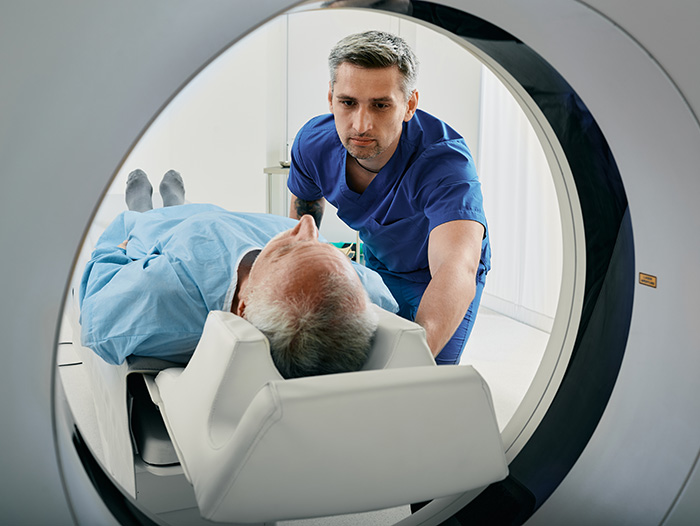According to a new study published in JAMA Internal Medicine, CT scans, a medical procedure undergone by millions of patients every year, could lead to over 100,000 new cancer cases.
Study details and key findings
CT scans use ionizing radiation to create an image of the inside of a patient's body, including their bones, muscles, organs, blood vessels, and more. Although the potential risk from CT scans is believed to be low, ionizing radiation can cause changes at the atomic level, which can lead to cell or organ damage.
For the study, researchers created a risk model using a multicenter sample of CT scans that were conducted between January 2018 and December 2020. The data, which came from the University of California San Francisco's CT Dose Registry, included information from 143 hospitals and outpatient facilities in 20 U.S. states.
In 2023, there were an estimated 62 million patients who underwent 93 million CT scans. Overall, the researchers projected that approximately 103,000 cancer diagnoses, or 5% of all cancers, would develop because of these CT scans.
Abdominal and pelvic CT scans were associated with the largest number of potential cancer cases, followed by chest CT scans. The most common cancers associated with CT scans were:
- Lung cancer (22,400 cases)
- Colon cancer (8,700 cases)
- Leukemia (7,900 cases)
- Bladder cancer (7,100 cases)
- Breast cancer (5,700 cases, second most common for women)
According to the researchers, children and teenagers have a higher risk of developing cancer from CT scans, but adults accounted for 90% of the projected cancer cases since they underwent the procedure more often.
"CT is frequently lifesaving, yet its potential harms are often overlooked, and even very small cancer risks will lead to a significant number of future cancers given the tremendous volume of CT use in the United States," the researchers wrote.
Commentary
The study's findings build on previous research of the potential impact of CT scans on cancer risk. For example, a 2009 study estimated that approximately 29,000 cancer cases could result from CT scans.
Since 2007, usage of CT scans has increased by 35%, which may have contributed to an increased risk of cancer from the procedure. According to the researchers, the study's findings suggest that the risk of CT scans is similar to other significant risk factors, including alcohol consumption (5.4%) and excess body weight (7.6%).
Many CT scans are "low-value, potentially unnecessary imaging," the researchers said, which exposes patients to unneeded radiation. According to a 2015 investigation from Consumer Reports, up to a third of CT scans could be unnecessary.
Rebecca Smith-Bindman, an epidemiology professor at the University of California, San Francisco and the study's lead author, said doctors need to be more judicious when ordering CT scans and that patients should ask questions to avoid having to undergo an unnecessary CT scan.
"Most patients will not develop cancer from a CT scan," Smith-Bindman said. "But if you're not getting any benefit, then even a small risk is unacceptable."
In an accompanying editor's note, Ilana Richman, from the Yale School of Medicine, and Mitchell Katz, from NYC Health + Hospitals, suggested several different ways to potentially reduce providers' reliance on CT scans, including implementing diagnostic algorithms to reduce CT scans among low-risk patients, using alternative imaging techniques like MRI and ultrasound, reducing the radiation dose in CT scans, and more.
"We need patients to ask their doctors, 'Can you use low dose when you scan me?'" Smith-Bindman said. "It's crazy that patients have to ask for it, but it's actually really successful."
However, other health experts emphasized the benefits of CT scans and said that patients should not try to avoid them if they're necessary.
"Any risk from a CT scan of a sick patient is likely much less than the risk of the underlying disease," said Cynthia McCollough, a CT imaging expert and past president of the American Association of Physicists in Medicine.
Separately, the American College of Radiology (ACR) issued a statement saying that while the "theoretical radiation risk" reported in the study is consistent with prior modeling studies, they are "not based on actual patient outcomes."
"There are no published studies directly linking CT scans (even multiple CT scans) to cancer," ACR said. "Americans should not forgo necessary, life-saving medical imaging and continue to discuss the benefits and risks of these exams with their healthcare providers."
Advisory Board's oncology resources
For more insights on oncology, check out these Advisory Board resources:
Growth in demand and costs, as well new technologies and disruptors, will change how cancer care is delivered, experienced, and paid for going forward. This resource outlines four predictions for how the cancer care delivery landscape will evolve by 2030.
Separately, this market insight explains three strategies organizations can use to leverage oncology pharmacists and improve cancer care. Similarly, these ready-to-use slides outline the major structural shifts impacting cancer care, as well as the strategic decisions that oncology leaders will need to make.
You can search through our oncology topics to see more related resources, including service line outlooks, case studies, and more.
(Cohen, "Shots," NPR, 4/16; Thompson, HealthDay, 4/16; Bassett, MedPage Today, 4/14; Cassella, Science Alert, 4/15; Moniuszko, CBS News, 4/14; Smith-Bindman, et al., JAMA Internal Medicine, 4/14)
Don't miss out on the latest Advisory Board insights
Create your free account to access 1 resource, including the latest research and webinars.
Want access without creating an account?
You have 1 free members-only resource remaining this month.
1 free members-only resources remaining
1 free members-only resources remaining
You've reached your limit of free insights
Become a member to access all of Advisory Board's resources, events, and experts
Never miss out on the latest innovative health care content tailored to you.
Benefits include:
You've reached your limit of free insights
Become a member to access all of Advisory Board's resources, events, and experts
Never miss out on the latest innovative health care content tailored to you.
Benefits include:
This content is available through your Curated Research partnership with Advisory Board. Click on ‘view this resource’ to read the full piece
Email ask@advisory.com to learn more
Click on ‘Become a Member’ to learn about the benefits of a Full-Access partnership with Advisory Board
Never miss out on the latest innovative health care content tailored to you.
Benefits Include:
This is for members only. Learn more.
Click on ‘Become a Member’ to learn about the benefits of a Full-Access partnership with Advisory Board
Never miss out on the latest innovative health care content tailored to you.


